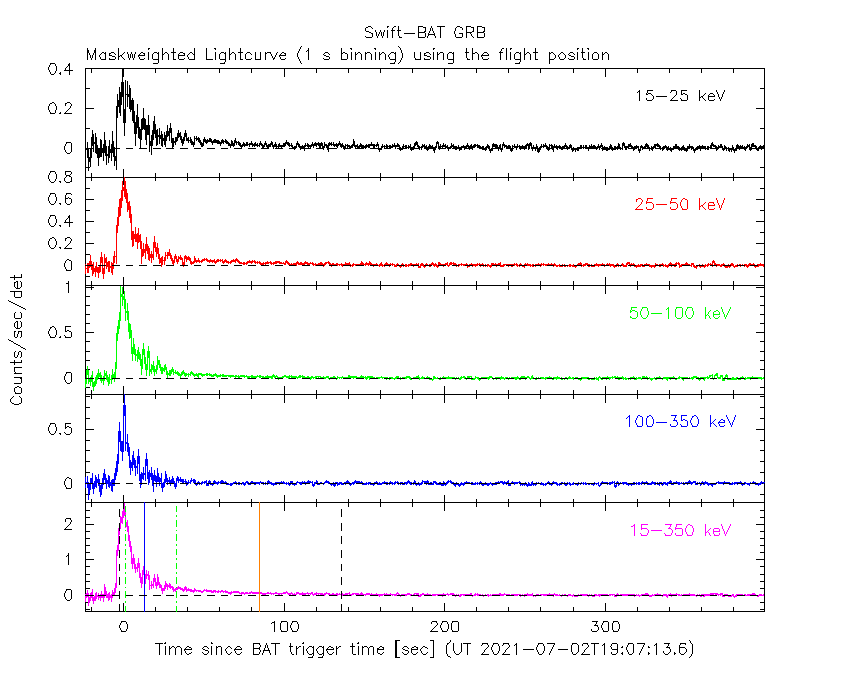
A.Y. Lien (GSFC/UMBC), V. D'Elia (SSDC and INAF-OAR) and N.P.M. Kuin (UCL-MSSL) for the Swift team
At 19:07:13 UT, the Swift Burst Alert Telescope (BAT) triggered and located GRB 210702A (trigger=1058804) (Lien et al. GCN Circ. 30351). Swift slewed immediately to the burst. At the time of the trigger, the initial BAT position was 87° from the Sun (4.4 hours East) and 136° from the 41%-illuminated Moon. Table 1 contains the best reported positions from Swift, and the latest XRT position can be viewed at http://www.swift.ac.uk/xrt_positions.
Lien et al. (GCN Circ. 30351) reported the discovery with UVOT of an optical afterglow. Groot et al. (GCN Circ. 30354) reported the position from MeerLICHT for the optical afterglow of this GRB. Kuin (GCN Circ. 30355) determined a redshift of 1.1757, and Xu et al. (GCN Circ. 30357) determined a redshift of 1.160 from VLT. Table 2 is a summary of GCN Circulars about this GRB from observatories other than Swift.
Standard analysis products for this burst are available at https://gcn.gsfc.nasa.gov/swift_gnd_ana.html.
As reported by Palmer et al. (GCN Circ. 30368),
the BAT ground-calculated position is RA, Dec = 168.570, -36.741 deg which is RA(J2000) = 1
The mask-weighted light curve (Figure 1) shows a single-peaked FRED-like structure that starts at ~T-4 s, peaks at ~T+1 s, and ends at ~T+370 s.
The burst went out of the BAT field of view at T+452 s.
There might be addition burst emission afterwards.
The results of the batgrbproduct analysis are available at https://gcn.gsfc.nasa.gov/notices_s/1058804/BA/.
Analysis of the initial XRT data was reported by D'Elia et al. (GCN Circ. 30358). We have analysed 48 ks of XRT data for GRB 210702A, from 101 s to 825.9 ks after the BAT trigger. The data comprise 310 s in Windowed Timing (WT) mode with the remainder in Photon Counting (PC) mode.
The light curve (Figure 2) can be modelled with an initial power-law decay with an index of α=0.986 (+0.017, -0.015), followed by a break at T+4365 s to an α of 1.455 (+0.028, -0.023).
A spectrum formed from the WT mode data can be fitted with an absorbed power-law with a photon spectral index of 1.570 (+0.018, -0.015). The best-fitting absorption column is consistent with the Galactic value of 1.2 x 1
A summary of the PC-mode spectrum is thus:
Galactic foreground: 1.2 x 1
Intrinsic column: 2.3 (+1.0, -0.9) x 1
Photon index: 1.96 ± 0.06
The results of the XRT team automatic analysis are available at http://www.swift.ac.uk/xrt_products/01058804.
The Swift/UVOT began settled observations of the field of GRB 210702A 104 s after the BAT trigger
(Kuin and Lien GCN Circ. 30356).
A source consistent with the XRT position is detected in the initial UVOT exposures.
Table 3 gives preliminary
magnitudes using the UVOT photometric system
(Breeveld et al. 2011, AIP Conf. Proc., 1358, 373).
No correction has been made for the expected extinction in the Milky Way
corresponding to a reddening of

Figure 1. The BAT
mask-weighted light curve in the four individual and total
energy bands. The units are counts

Figure 2. The XRT light curve.
Any data from a crosshatched region are not included in the fit.
| RA (J2000) | Dec (J2000) | Error | Note | Reference |
|---|---|---|---|---|
| 1 |
-36°44'50.0" | 0.42" | UVOT-refined | Kuin and Lien GCN Circ. 30356 |
| 1 |
-36°44'49.7" | 1.9" | XRT-final | UKSSDC |
| 1 |
-36°44'49.7" | 1.9" | XRT-refined | D'Elia et al. GCN Circ. 30358 |
| 1 |
-36°44'29.2" | 1.5' | BAT-refined | Palmer et al. GCN Circ. 30368 |
| Band | Authors | GCN Circ. | Subject | Observatory | Notes |
|---|---|---|---|---|---|
| Optical | Lipunov et al. | 30352 | Swift GRB210702.80: Global MASTER-Net OT detection |
MASTER | detection |
| Optical | Lipunov et al. | 30353 | Swift GRB 210702A: Global MASTER-Net observations report |
MASTER | |
| Optical | Groot et al. | 30354 | MeerLICHT multi-colour photometry | MeerLICHT | |
| Optical | Xu et al. | 30357 | VLT/X-shooter redshift | VLT | redshift |
| Optical | F. Romanov | 30364 | iTelescope optical afterglow observations |
iTelescope | |
| Optical | Belkin et al. | 30365 | Chilescope optical observations | Chilescope | detection |
| Optical | Hu et al. | 30367 | BOOTES-3/YA optical counterpart observations |
BOOTES-3 | detection |
| Radio | Laskar and Perley | 30423 | ALMA detection | ALMA | detection |
| Radio | Laskar et al. | 30424 | ATCA detection | ATCA | detection |
| Radio | Laskar and Bhandari | 30477 | ATCA detection of radio rebrightening | ATCA | detection |
| Radio | Laskar | 30479 | ALMA detection of mm-band rebrightening | ALMA | detection |
| Radio | Laskar et al. | 30538 | MeerKAT radio detection | detection | |
| Gamma-ray | Yamaoka et al. | 30362 | CALET Gamma-Ray Burst Monitor detection | CALET | |
| Gamma-ray | Ursi et al. | 30363 | AGILE detection | AGILE | |
| Gamma-ray | Frederiks et al. | 30366 | Konus-Wind detection | Konus-Wind |
| Filter | Exp(s) | Mag | ||
|---|---|---|---|---|
| white | 104 | 254 | 147 | 15.70 ± 0.02 |
| b | 3516 | 3716 | 197 | 15.46 ± 0.03 |
| u | 316 | 361 | 44 | 11.37 ± 0.05 |
Table 3. UVOT observations reported by Kuin and Lien (GCN Circ. 30356). The start and stop times of the exposures are given in seconds since the BAT trigger. The preliminary detections and 3-σ upper limits are given. No correction has been made for extinction in the Milky Way.
August 19, 2021